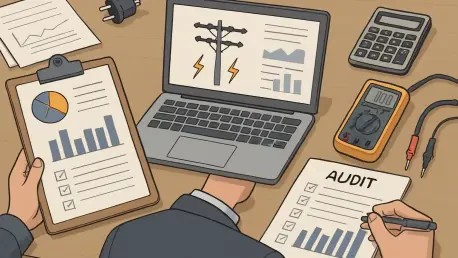Short introductionToday, we’re thrilled to sit down with Christopher Hailstone, a seasoned expert in energy management, renewable energy, and electricity delivery. With his deep expertise in the electric utility sector, Christopher offers invaluable insights on grid reliability, security, and navigating the complex world of regulatory audits. In this conversation, we explore the growing scrutiny on affordability, the importance of strategic audit preparation, and how utilities can turn these challenges into opportunities to build trust and credibility with regulators and customers alike.
Can you explain why regulatory audits are becoming more frequent and detailed for electric utilities in recent years?
Absolutely. The increased frequency and detail of audits stem from a perfect storm of factors. Customer bills have been climbing due to volatile fuel costs, significant investments in transmission and distribution, and the integration of renewable energy sources, which often come with upfront costs. Regulators are under pressure to ensure these costs are justified and that utilities are prioritizing affordability. On top of that, public and political interest in how utilities manage resources has grown, making audits not just a compliance check but a public accountability exercise. It’s about proving that every dollar spent delivers value to customers.
How has the focus on affordability shifted the way audits are conducted compared to, say, a few years ago?
A few years back, audits were often more about ticking boxes—ensuring compliance with technical standards and financial reporting. Now, affordability is front and center. Regulators are digging deeper into how costs translate to customer benefits, asking for detailed justifications of investments like grid upgrades or renewable projects. They want to see a direct link between spending and outcomes like reliability or lower long-term rates. This shift means utilities face tougher questions and need to be ready with data that tells a compelling story about value, not just compliance.
What are some of the biggest challenges utilities face when they only react to audits rather than preparing proactively?
Reacting instead of preparing puts utilities in a tough spot. They’re often scrambling to pull together data, align their internal teams, and craft responses under tight deadlines. This can lead to incomplete or inconsistent information being presented, which raises red flags with regulators. Beyond that, a reactive approach means they miss the chance to shape the narrative. Instead of showcasing their strengths, they’re just firefighting, which can erode trust and make the process feel like a battle rather than a collaboration.
Can you share an example of how a lack of preparation has impacted a utility’s reputation or relationship with regulators?
Certainly. I’ve seen cases where a utility didn’t have its documentation in order for a major capital project—like a grid modernization initiative. When the audit came, they couldn’t quickly provide evidence linking the investment to improved reliability or cost savings. The regulators had to dig deeper, which delayed the process and created a perception of disorganization. That not only strained the relationship with the regulatory body but also made headlines, damaging public trust. It’s a stark reminder that preparation isn’t just about passing an audit; it’s about protecting your reputation.
You’ve mentioned a strategic approach to audits using the Audit Readiness Test, or ART. Can you walk us through what that framework involves?
The Audit Readiness Test, or ART, is a structured way to prepare for audits by focusing on key disciplines like governance, evidence management, and scenario planning. It starts with establishing clear accountability across departments—making sure everyone knows their role in the audit process. Then, it emphasizes building a robust evidence base, so all claims are backed by solid data. ART also includes simulating audit requests to spot gaps in advance and planning for various scenarios, like cost spikes or project delays. The goal is to ensure a utility isn’t just compliant but can present a unified, persuasive case to regulators.
Why is presenting a consistent story during an audit so critical for utilities?
A consistent story is everything because audits are as much about perception as they are about facts. If different departments give conflicting explanations about, say, why a project went over budget, it signals disarray and invites deeper scrutiny. Regulators start to question whether the utility has its act together. A unified narrative—where everyone from operations to finance is on the same page—builds credibility. It shows that the utility understands its decisions, can justify them, and is transparent about its goals, which is key to maintaining trust.
How can utilities ensure they have solid evidence to support their claims during an audit?
It starts with disciplined record-keeping long before an audit is even on the horizon. Utilities need to maintain detailed, accessible documentation—think policies, cost allocations, operational records, and rate case filings—that clearly ties spending to customer benefits. For instance, if you’ve invested in storm hardening, you should have data showing reduced outages or faster recovery times. Regular internal reviews help ensure this evidence is organized and ready to go. Without it, you’re left making claims you can’t back up, and that’s a fast track to losing credibility with regulators.
Why do regulators care about a utility’s commitment to future improvements, and how can utilities demonstrate this focus?
Regulators aren’t just looking at past performance; they want assurance that utilities are thinking ahead, especially on affordability and efficiency. Showing a commitment to future improvements signals that a utility isn’t resting on its laurels—it’s actively working to deliver better value. Utilities can demonstrate this by presenting clear plans, like programs to reduce operating costs or initiatives to support low-income customers. For example, outlining a roadmap for smart grid investments that promise long-term savings can impress auditors and show you’re aligned with public interest.
How does benchmarking against peers play a role in audit preparation for utilities?
Benchmarking is crucial because regulators often compare utilities to their peers to gauge performance and cost-effectiveness. Metrics like system reliability—think outage duration or frequency—and operating costs per customer are commonly used. If a utility knows where it stands relative to similar companies, it can contextualize its results and explain why certain costs or outcomes make sense. Without this perspective, a utility might seem out of step, even if its numbers are reasonable. Benchmarking helps build a stronger case by showing you’re competitive or, if not, why that’s the case.
What is your forecast for the future of regulatory audits in the electric utility sector?
I expect regulatory audits to become even more rigorous as affordability pressures grow and the transition to clean energy accelerates. We’ll likely see an even sharper focus on how utilities balance cost with sustainability goals, especially as renewable integration and grid modernization require significant investment. Regulators will demand greater transparency and more granular data to justify every expense. At the same time, I think utilities that embrace proactive preparation and embed audit readiness into their daily operations will stand out—they’ll turn audits into opportunities to showcase innovation and commitment to customers. It’s going to be a challenging but exciting time for the sector.









